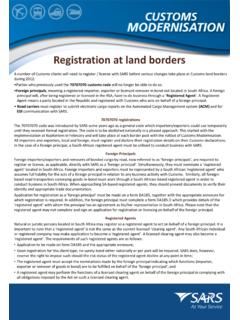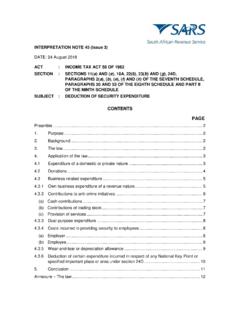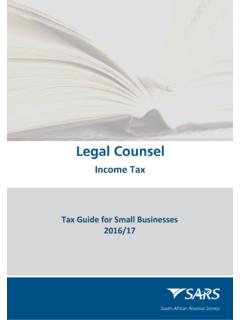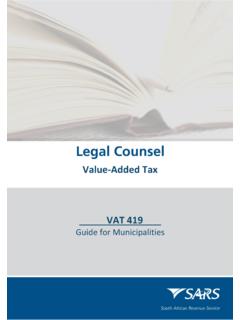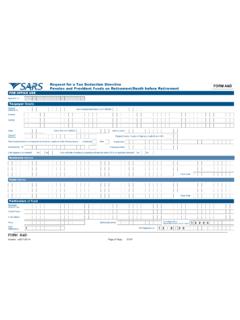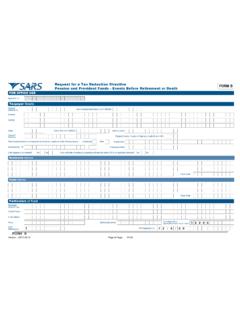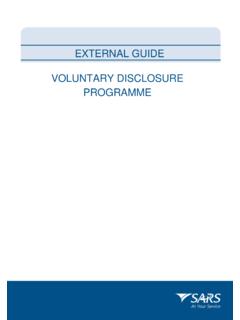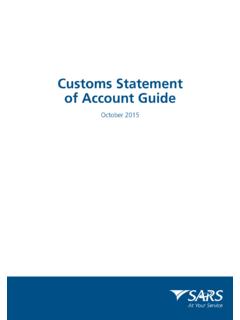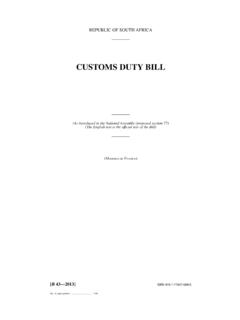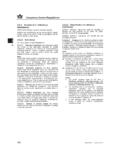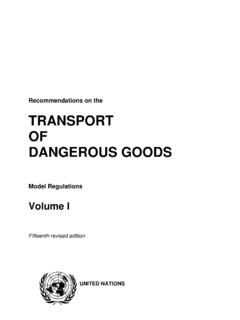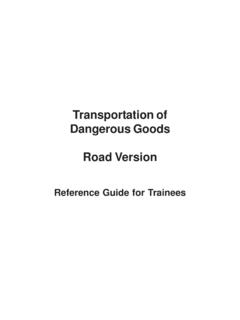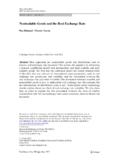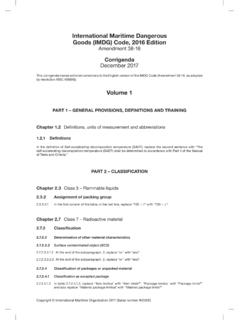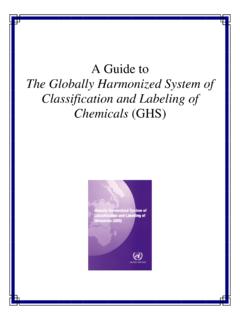Transcription of CUSTOMS EXTERNAL DIRECTIVE TARIFF …
1 Effective 25 March 2014 CUSTOMS EXTERNAL DIRECTIVE TARIFF classification Effective 25 March 2014 TARIFF classification EXTERNAL DIRECTIVE SC-CR-A-09 Revision: 1 Page 2 of 15 TABLE OF CONTENTS 1 SUMMARY OF MAIN POINTS 3 2 DIRECTIVE 3 The Explanatory Notes to the Harmonised System (HSEN) 3 Determining a TARIFF heading 3 Staged Consignments 5 Analysis Fees 5 Record keeping 5 Penalties 5 Appeals against decisions 6 PRACTICE 6 General Rules for the interpretation of the Harmonised System 6 Rule 1 6 Rule 2 7 Rule 3 8 Rule 4 11 Rule 5 11 Rule 6 12 Preparing a TARIFF Application (DA 314) 12 RELATED INFORMATION 14 Legislation 14 Cross References 14 Quality Records 14 DEFINITIONS AND ACRONYMS 14 6 DOCUMENT MANAGEMENT 15 Effective 25 March 2014 TARIFF classification EXTERNAL DIRECTIVE SC-CR-A-09 Revision: 1 Page 3 of 15 1 SUMMARY OF MAIN POINTS a) All import and export transactions require declarations according to an appropriate TARIFF heading.
2 B) TARIFF classification is the process whereby any imported or exported commodity is categorised by virtue of: i) what it is; ii) how it is made; or iii) what it is used for. c) The TARIFF classification code is directly linked to the rate of duty payable on that commodity. Items are classified in terms of the International Harmonised Commodity and Coding System (Harmonised System), under the World CUSTOMS Organisation (WCO) Harmonised System Convention to which South Africa is a contracting party. d) All member countries of the WCO must use a uniform TARIFF up to the first six (6) digits of the TARIFF code. In addition South Africa has in Schedule 1 expanded the international tariffs with two further sub digits which must also be declared. e) The verification and classification of imported or exported goods are specifically mentioned in the provisions of: i) Section 47(9); and ii) The rules of classification .
3 2 DIRECTIVE The Explanatory Notes to the Harmonised System (HSEN) a) The interpretation of Schedule 1 Part 1 is in terms of Section 47(8)(a) subject to the Explanatory Notes (HSEN) issued by the WCO. The HSEN sets out in a systematic form the goods handled in international trade. It groups these goods in sections, chapters and sub-chapters, which have been given titles indicating as concisely as possible the categories or types of goods they cover. In many cases, the variety and number of goods classified in a section or chapter are such that it is impossible to cover them all or to mention them specifically in the titles. The HSEN are the most important classification tool, as it constitutes the official interpretation of the Nomenclature at international level. The HSEN follows the systematic order of the Harmonised System, provides commentary on the scope of headings and where appropriate also subheadings.
4 B) The HSEN must be used in difficult and doubtful cases to explain or supplement the heading and Notes, not override or contradict them. c) The HSEN must be used to ascertain the correct interpretation of the Harmonised System itself, however, is not an exhaustive, unchangeable commentary on the overall scope of the headings and subheadings of the Harmonised System. The HSEN must always be read in strict conformity with the texts of the Harmonised System itself from which they cannot be disassociated and in particular with the Interpretive Rules and the section and chapter notes. d) TARIFF classification is specifically governed by Section 47(9) and is therefore required knowledge for any prospective classifier. Determining a TARIFF heading a) CUSTOMS may in writing determine the TARIFF -heading on imported or exported goods as a result of an application for a TARIFF determination on a DA 314 or on a report made by a delegated Branch Officer.
5 Effective 25 March 2014 TARIFF classification EXTERNAL DIRECTIVE SC-CR-A-09 Revision: 1 Page 4 of 15 b) In terms of Section 47(9)(a)(ii) a declaration released as entered is not deemed to be a determination. c) An opinion given verbally is not regarded as a TARIFF determination. d) The Commissioner may publish the TARIFF determinations in the Government Gazette [Section 47(9)(c)]. e) The Commissioner may amend or withdraw a determination and make a new determination [Section 47(9)(d)]. The new determination will be in effect from: i) The date of first entry of the goods in question; ii) The date of the notice in the Government Gazette; iii) The date of the first determination; iv) The date of the new determination; or v) The date of the amendment from the old to the new determination. f) Any determination that has been made is deemed to be correct but subject to appeal to the Court. Therefore, any amount due as a result of such a determination remains payable for as long as such a determination remains in force [Section 47(9)(b)].
6 G) To determine the classification of goods between Harmonised System headings clients must apply a three (3) stage process: i) Firstly, ascertain the meaning of the words used in the headings and relative section as well as the chapter notes, which may be relevant to the classification of the goods concerned. Schedule 1 Part 1: A) Has general application, meaning that it was not intended to deal with a particular trade. B) Is subject to the ordinary recognised principles of statutory interpretation: I) The most important rule in this regard is to give words their ordinary grammatical meaning, unless the context or the subject clearly shows that they were used in a different sense. II) Definitions assigning specific meanings to words and expressions in legislation, or as a result of case law, must be adhered to unless the context otherwise indicated. ii) Secondly, considers the nature and characteristics of the goods. iii) Thirdly, select the heading which is most appropriate to the goods, taking the relevant headings, as well as the section and chapter notes into consideration, which must be interpreted in conformity with the Explanatory Notes.
7 A) Rules of classification are used to determine the correct TARIFF heading. There are six (6) general rules for the interpretation of the Harmonised System, which must be applied in a strict hierarchical order. The rules are an integral part of the Explanatory Notes providing for a uniform application of the Harmonised System. The six (6) rules are: # APPLICATION 1 General Rule 2(a) Incomplete or unfinished, unassembled or disassembled goods 2(b) Mixtures or combinations 3(a) Two (2) or more combinations - Most specific 3(b) Two (2) or more combinations - Essential character 3(c) Two (2) or more combinations - Last in numerical order 4 Most akin (alike) 5(a) Special containers 5(b) Packing materials and containers 6 Subheading texts, notes and rules 1 to 5 above B) The first five (5) rules relate to the 4-digit headings and the last rule relates to classification in the 5- or 6-digit subheadings of the Harmonised System. Effective 25 March 2014 TARIFF classification EXTERNAL DIRECTIVE SC-CR-A-09 Revision: 1 Page 5 of 15 Staged Consignments a) TARIFF classification of staged consignments differs from the norm.
8 From a legal point of view, goods are normally classified as presented at the time of importation by a specific importer. b) With staged consignments, in most instances, only one (1) TARIFF heading is utilised and is determined according to the essential character of the whole consignment (SC-CF-48). Analysis Fees a) In terms of Section 107(2)(b), CUSTOMS may direct that goods be analysed by a person designated by CUSTOMS and that the analysis be done in accordance with a method determined by CUSTOMS . b) The party requesting the analysis is liable for the analysis fees. This is normally the importer or exporter requesting a TARIFF determination, except: i) Where CUSTOMS considers analysis necessary and this analysis: A) Confirms the correctness of a declaration made or presented by a client then CUSTOMS is liable for the cost; or B) Shows that the goods in question were incorrectly or insufficiently described on the invoice, the importer or exporter (whichever is applicable) is liable for the cost; and ii) In the case of a refund or substitution of a declaration the costs of the analysis is never borne by CUSTOMS .
9 C) When application is made to CUSTOMS for a refund of analysis fees paid, the letter must be forwarded to Head Office. Record keeping a) The recipient or importer of the goods imported or exported by post must keep for record purposes for a period of five (5) years: i) Books, accounts and documents in respect of all transactions relating to the Rules for the purpose of any acquittal procedure; and ii) Any data related to such documents created by means of a computer. b) The five (5) year period is calculated from the end of the calendar year in which the document was created, lodged or required. (Sections 101 and 101A) c) Every client must produce such books, accounts and documents on demand. Penalties a) Failure to adhere to the provisions of the Act, as set out in this document, is considered an offence. b) Offences may render the recipient or importer liable to, as provided for in the Act: i) Monetary penalties; ii) Criminal prosecution; and/or iii) Suspension or cancellation of registration, license or accreditation.
10 Effective 25 March 2014 TARIFF classification EXTERNAL DIRECTIVE SC-CR-A-09 Revision: 1 Page 6 of 15 Appeals against decisions a) In cases where clients are not satisfied with any decision taken in terms of the CUSTOMS and Excise Act they have a right of appeal to the relevant appeal committee. The policy in this regard, as well as the process to be followed, is contained in document SC-CC-24. b) Should clients be unhappy with a decision of any appeal committee their recourse will be to lodge an application for ADR (Alternative Dispute Resolution) with the relevant appeal committee. The committee will add its comments thereto and forward the application to the ADR Unit for attention. The policy in this regard, as well as the process to be followed is contained in document SC-CC-26. c) If clients wish to appeal any decision in terms of VAT penalties, they are directed to the provisions of Section 215 to 220 of the Tax Administration Act No.
